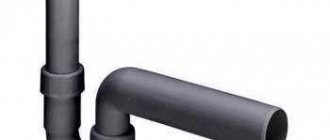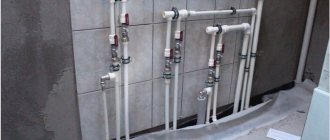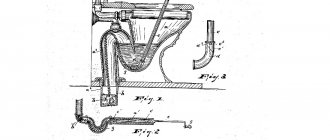There are many pipes in the bathroom and toilet of every residential apartment. Some of them deliver water inside our homes for our sanitary and hygienic needs, while others, on the contrary, transport waste water and waste to the sewer system.
As a rule, communications passing through your bathroom are connected to centralized water supply and sewerage systems, thanks to which they function perfectly. However, most of the houses in our country are still built in the Soviet Union; they have not seen a major renovation for a long time, and therefore these systems are gradually falling into disrepair.
Replacement of pipes in the bathroom and toilet can be carried out for various reasons: due to wear, due to the transition to more modern materials, or due to redevelopment in the bathroom. In this article we will figure out how difficult it is to replace communications with your own hands, as well as how much it will cost.
When to change
Cast iron risers, due to their gentle operating mode, in which their contact with liquid waste occurs only briefly and the falling flow does not completely wash the walls, work in sewer systems for quite a long time. In multi-storey buildings on the upper floors, a cast iron riser will last much longer and will become less clogged, unlike the first floors, where the riser drain is in contact with the liquid for a longer time. The need to replace the riser may be caused by the following reasons:
- Physical deterioration . During operation, the walls of cast iron risers become thinner due to low corrosion resistance, cracks and fistulas form in them, pipes leak, and there is an unpleasant odor in the bathroom.
- Frequent blockages . With prolonged use, the inner shell of pipe risers becomes covered with plaque; over time, its thickness increases - this leads to the fact that the throughput of the pipeline decreases and in emergency situations the passage channel becomes clogged.
Rice. 2 Damaged drain pipe
- Mechanical damage. Cast iron is a brittle material; when struck by sharp, heavy objects, it splits and cannot be repaired. When carrying out major repairs, situations sometimes arise when the old internal sewer pipeline of an apartment in the inlet pipe of the riser is broken, and the shaped element (tee, cross) may crack. The adapter from the internal sewerage system to the riser cannot be restored - it must be replaced, and the riser pipe will also have to be removed, and if it is very worn out and clogged with plaque, it must be replaced.
- Repair. When carrying out renovations in an apartment, it may be necessary to replace the tee in the sewer riser that supplies wastewater to a vertical pipe to change its configuration, using modern PVC products. In this case, it is easier and more reliable to install a plastic product instead of an old worn-out cast iron pipe, which is not intended for joining with shaped polymer parts.
- Noise insulation. If an inexpensive PVC pipe riser is installed in the house, when using the sewerage system, noise often occurs in it, reducing the comfort of living and using the toilet. One of the radical options for combating sewer noise is to replace the vertical riser pipe with a low-noise, specially designed one that has a higher mass and, accordingly, cost.
Rice. 3 Low noise sewer pipes
Fan pipe installation
Often, the drain pipe, which is a continuation of the sewer riser, is made from a pipe of the same material and diameter. At the exit, the fan pipe is installed in the ventilation duct included in the building design and installed during the construction of the house.
Often the fan pipe is routed through the wall in a horizontal position. This design arrangement can be used in buildings created according to individual projects or private homes. From the outside, the pipe exit is masked with special gratings or other methods.
Options for vent pipe output to the roof
The outlet of the drain pipe on the roof of the building is also protected by an umbrella to eliminate the possibility of debris, rain and birds getting into the pipe, which could lead to clogging of the sewer system.
The presence of a drain pipe allows you to avoid the appearance of unpleasant odors in the room when the plumbing equipment is not used for more than one week. During this period, in modern plumbing systems with small siphons, the water seal may dry out. Warm air from the room, rising along the sewer riser, comes into contact with cold air from outside and creates some vacuum in the structure. The resulting draft helps the air from inside the siphons to escape into the open space.
Who should carry out and pay for the replacement?
Maintenance of water supply and sewerage systems of residential buildings, as well as other engineering communications, is regulated by the Housing Legislation, Methodological Guidelines for the Maintenance and Repair of Housing Stock MDK 2-04.2004, according to which responsibilities are divided between the owner and the service organization (MC or ZhES).
According to the rules, all communications located inside the apartment are maintained or replaced by the owner himself, or with the involvement of specialists from third-party companies at his expense. If emergency situations occur inside the apartment, the owner is financially responsible for the damage caused to the neighbors below.
The vertical riser of an apartment building itself is common property, as are all the cross-shaped and tee-shaped parts in it up to the junction with the internal sewer pipeline.
Further distribution of the drain and sewer pipeline is private property and is not subject to free repairs by operational services.
Thus, when a sewer riser is leaking, the question of who should repair or replace it has a clear answer: repairing and replacing a sewer riser is the responsibility of housing and communal services workers or management companies; all work must be carried out free of charge.
Finance is obtained from contributions for major repairs or payments made for the use (maintenance) of residential premises.
If the user intends to replace a working riser with a new one for various reasons, it is clear that he must pay for the work and components carried out out of his own pocket.
Rice. 4 Example of an application
How to change at the expense of the Criminal Code
The procedure for free replacement of a faulty riser with the involvement of specialists from the management company is carried out in the following order:
- A plumber is called to the house, who inspects the riser, draws up a report, records all damage and confirms the validity of the replacement.
- After this, a free-form application is drawn up in 2 copies addressed to the boss, indicating the reasons for the replacement, the second copy remains in hand.
It is important that the owner does not have rent debts, otherwise the application may not be accepted for consideration, and the repair of the riser or its replacement may be denied.
- After a positive response to the application, a time is agreed upon; before starting work, plumbers visit the apartments above and warn residents about the temporary cessation of using the sewerage system.
- The tenant provides free access to the riser; most likely, he will have to remove the toilet himself or entrust this to plumbers for an additional fee; there are no other costs for replacement.
Sometimes the management company misleads residents with the statement that the riser is located in the apartment, and therefore, all costs for its repair (replacement) must be borne by the owner. With this approach, it is useful to draw the management’s attention to the document MDK 2-04.2004, according to which all sewer risers, heating radiators, water pipes in an apartment panel or brick building are common property and therefore their maintenance, repair or replacement should be carried out by the management company of the management company.
If a cast-iron sewer riser is replaced with a plastic one with the involvement of third-party specialists, the price of the work, depending on the complexity, is in the range of 5,000 - 7,000 rubles.
Rice. 5 Replacement parts
Dismantling the old riser
If your riser is leaking, or you suspect that this may happen in the near future, then first analyze how the sewerage system in your home is arranged.
Please note that a riser that does not pass through the ceilings, that is, laid in a special shaft, cannot be touched independently. Otherwise, a very complex repair of the entire sewer shaft may be necessary.
If the sewer riser passes through the floors, then it has additional fastenings in these places, and any part of it can be dismantled and replaced.
How to change it yourself
Partial or complete replacement of a cast iron riser is possible only with a plastic analogue, this is due to the fact that during installation the riser column is installed from the bottom up with pipes on top of each other in the nozzles, and to replace one of the fragments, a special compensation coupling is required, which allows inserting less than long pipe. Such products are difficult to find in shaped elements for the installation of cast iron, but they are produced in a wide range in the PVC pipe product line.
Tools and components
Before replacing the sewer riser in an apartment, purchase the following components:
- A plastic pipe along the height of the riser with a standard outer diameter of 110 mm.
- A typical cross with two 50 mm outlets for connecting drain pipes in the bathroom and kitchen sink and with one outlet for connecting a toilet. If the apartment has only one common outlet for transporting gray waste, use the appropriate tee.
- Rubber cuffs (in the absence of adapters from cast iron to plastic), one will be needed when installing a cross (tee) into the neck of the lower cast iron pipe, the other is put on the outside on the pipe end coming out from above.
Rice. 6 Single-pipe sewerage distribution inside the apartment
- An expansion coupling, which is a piece of pipe with an elongated expanded pipe with an internal diameter of 110 mm - thanks to this, the inserted pipe element can be moved within it over a certain distance.
- A transitional plastic coupling with a built-in cuff, which, if necessary, is installed in the socket of the lower sewer pipe and serves to adjust the cross to the required height if it is impossible to directly connect it with a cast iron saddle recessed in the floor.
- A transitional PVC coupling from plastic to cast iron with a rubber cuff inside the socket for the upper connection, its lower end is inserted into an expanded pipe with a rubber ring of a vertical plastic pipe.
- Metal clamps with rubber gaskets with an internal diameter of 110 mm, designed for fastening plastic riser pipes to the wall.
Rice.
7 Tools From plumbing and construction tools you will need to carry out the work:
- Angle grinder (grinder) with a metal disc for cutting cast iron and plastic pipes.
- A hammer drill for drilling holes in the wall, removing screeds and cement caulking in cast iron joints.
- Chisel, chisel, heavy hammer or sledgehammer for caulking joints and breaking cast iron pipes.
- Pencil, tape measure or ruler.
- A blowtorch for melting caulking materials - sulfur, lead, epoxy resin, is used in case of incomplete replacement of the riser, if it is necessary to leave the cross or part of the pipe intact.
- Protective clothing, gloves, glasses, respirator.
Rice. 8 Dismantling a wall riser - basic operations
Dismantling and caulking
When joining cast iron riser pipes, a pipe connection was previously used, in which a variety of materials were used to seal the joints instead of a rubber seal. Workers carried out the joining using various methods, depending on the technology adopted in the organizations: poured molten sulfur or lead into the cracks, laid fabric and coated the outside with thick cement, poured epoxy resin, pushed in a cord or rope soaked in bitumen mastic.
The main task of dismantling is to destroy the cast iron pipe connection using several methods. Depending on the sealing material, it is carried out in the following sequence:
- Before starting work, be sure to visit all neighbors on the floors above and ask them not to use the kitchen sink, bathtub, and toilet for some time.
- The toilet is removed and put away; to do this, disconnect the corrugation from the riser outlet, having first drained the water from the tank and shutting off its flow with the tap below, unscrew the toilet mounting screws and the supply hose, and take the toilet outside the sanitary unit.
Tip: After removing the toilet, be sure to lean the tank against the wall - otherwise, under the weight of the flush tank, it will turn over and most likely break.
Rice. 9 Methods for caulking cast iron joints
- Using a puncher, knock down the screed at the bottom, freeing and cleaning the junction of the cross with the pipe; if the solution from above interferes with dismantling and covers the outer shell of the exiting pipe, it is also knocked out.
- Use a grinder to cut the vertical pipe of the riser in the transverse direction at any convenient distance from the floor (about 0.5 m, so that you can place a bucket under the pipe); if it is impossible to get close to the pipe shell near the wall with a machine, use a practically used metal disc of small diameter. It is not necessary to make a through cut - if the pipe is not needed, it is subsequently broken with a heavy sledgehammer or hammer.
- Insert the chisel into the seam on the pipe obtained from the grinder disk and hit it forcefully with a hammer, trying to break the body; after it bursts, remove the fragments to the side. To avoid unexpected water flow from above, despite the warning, place a bucket under the cut pipe.
- They try to pull the cross out of the pipe of the lower pipe (you should be careful here; if the riser is broken, the expansion pipe may be damaged); if this presents difficulties, they use various methods of disconnection.
Note: When cement-sand sealing, the mortar is knocked out with a hammer and chisel, the frozen sulfur, lead, soaked rope and epoxy resin are heated and melted with a blowtorch, after which the crosspiece is pulled up.
- After dismantling the crosspiece, clean the lower pipe from dirt and debris to avoid blockages and begin dismantling the upper section of the pipe. It is pulled down, if resistance is encountered, the outer pipe is heated with a blowtorch, the shell can be carefully broken with a hammer, being careful not to damage the end of the riser coming out from the ceiling.
- After dismantling work, a fragment of the shell of the upper cast-iron pipe should remain on the ceiling, and in the floor there should be an expanding pipe of the lower pipe with the outer and inner surfaces, respectively, cleared of dirt.
If none of the above methods fails to remove the lower tee or upper pipe, they are cut with a grinder and adapters or couplings of a suitable outer or inner diameter are selected.
Rice. 10 Assembly diagram with examples
Installation of a new riser
After preparing the end sections of the inlet and outlet cast iron pipes, they begin to install the plastic riser, in which case it is necessary to join the cast iron and plastic pipes with internal bore diameters of 100 mm. The outer diameter of a standard cast iron pipe is 118 mm, the internal size of its cone-shaped socket is 123 - 127 mm. The plastic sewer PVC pipe has an outer size of 110 mm, and the inner diameters of the shell are 100 mm, and the socket is 110.4 mm.
It follows from this that to connect the PVC pipe at the top you will need an adapter from plastic to cast iron with outer and inner diameters of 110x120 mm, respectively, and a built-in rubber cuff. If the tee is being replaced from below in a sewer riser, the adapter from plastic to cast iron should have dimensions of 110x120 mm (inner and outer diameter) and an outer cuff, which is inserted into the cast iron socket (Fig. 10).
Installation of the riser is carried out in the following sequence:
- Place a transition coupling from plastic to cast iron with an internal rubber seal on a section of cast iron pipe protruding from the ceiling.
- Install a cross with a rubber cuff into the saddle of the lower cast iron riser; if necessary, install an adapter from plastic to cast iron with a similar seal.
- Place a vertical riser PVC pipe into the gap between the upper and lower sections, cut it 30 - 50 mm shorter, and put an expansion sleeve on its lower end until it stops.
- Place the assembled system vertically in the riser; if the length is too long, the pipe is further trimmed. After the ends of the structure coincide in height with the inlet and outlet openings, the compensation pipe is lowered down the pipe, immersing it in the tee at a distance of 30 - 50 mm.
- The riser is secured with rubber clamps to the mating part of the clamps with screws screwed into the wall in advance, the distance between the fasteners is about 400 mm.
Rice. 11 Installation of the riser
Important Tips
When carrying out operations to replace the riser with your own hands or with the help of plumbers, it is useful to adhere to the following recommendations:
- The main reason for replacing a cast iron sewer riser is frequent blockages associated with low channel permeability, or significant damage in the form of cracks and falling out fragments . All other malfunctions in the form of leaks, fistulas can be easily eliminated with your own hands using sealing materials: cold welding, epoxy resin and others. Large damaged areas can be covered with applied rubber cuffs secured with clamps - due to the low pressure in the sewer line, high strength patches are not required to repair any damage.
- Many novice and experienced plumbers carry out meaningless manipulations with sealant, covering cuffs and rubber seals in pipes with it. The sealant is intended for sealing cracks and seams between hard surfaces and is not an adhesive; when deformed, it will not adhere to elastic rubber and will even cause harm, preventing the rubber seal from fitting tightly to the pipe casings.
- When installing brittle plastic into a vertical gap in a cast-iron sewer line, there is a high probability of it being compressed by the upper column; to eliminate the danger, measures should be taken to additionally secure the upper pipe. Its protruding end is attached to the wall with additional clamps; if possible, you can coat the shell with concrete contact, special glue, and wall up the free area in the wall using materials with good adhesion to cast iron or its new coating.
- In order not to waste a lot of time when dismantling the old and installing a new riser, it is better to caulk it in advance without removing the pipes. Using a chisel or a sharp screwdriver, knock out the most common cement putty at the top and bottom; if a leak suddenly appears, it is temporarily sealed with plasticine.
Rice. 12 Price list for the services of one of the companies
Replacing a cast-iron riser pipe with a plastic one can be done with your own hands; the task is greatly simplified if the apartment is located on the upper floors and the caulking is done poorly using fragile materials. To install a polymer riser, you will need a pair of transition couplings from cast iron to plastic, a cross or tee, a piece of pipe of suitable length, in addition to the standard construction tool in the form of an angle grinder and a hammer drill, you may need a blowtorch.
Completion of work
After installing the central riser, a cross is attached to the outlet tee - an internal branch distributor (for connecting a toilet, bathroom, kitchen and other plumbing devices). The final stage is sealing holes in the ceiling and ceiling, as well as other damage to the wall and ceiling. For this, a cement-sand mortar is used. A sealing layer should be applied to the surface of the pipe in the area where the interfloor ceiling passes. Upon completion of all work, it is necessary to carry out verification tests by draining the water. All leaks must be repaired immediately by additionally applying sealant or applying a sealing compound.











